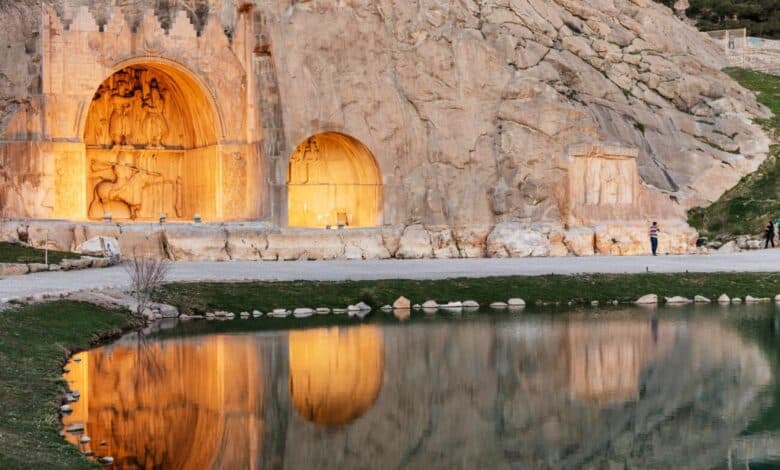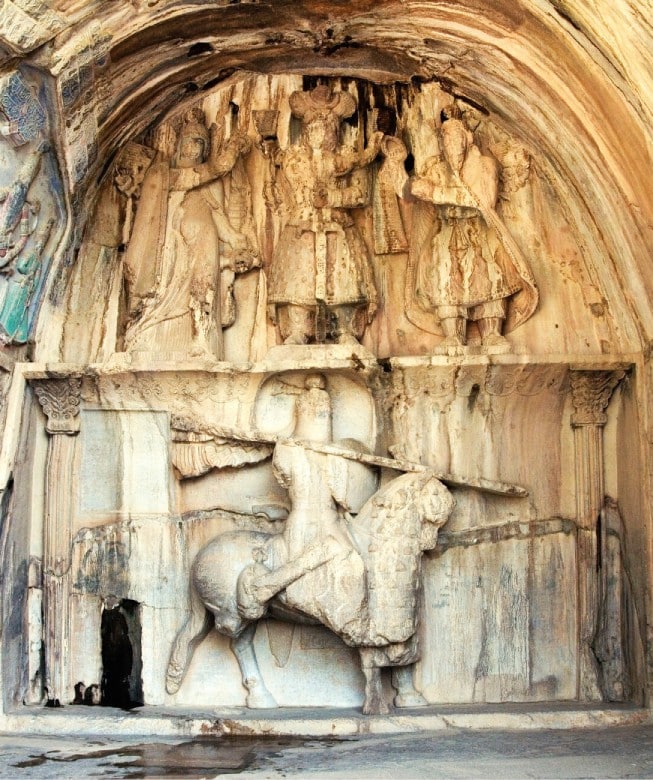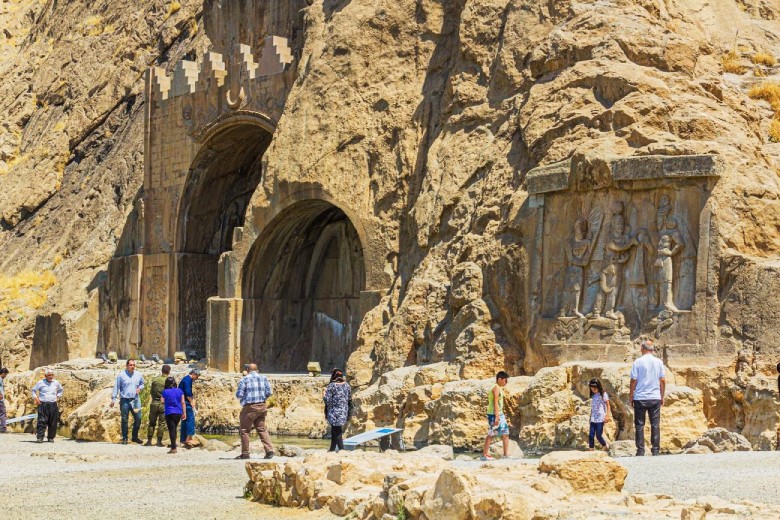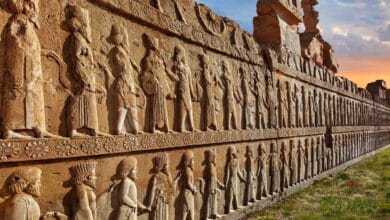Taq-e Bostan, the Greatest Construction in Kermanshah
A Treasure Trove of Ancient Rock Art and Architectural Splendor

Taq-e Bostan or Tagh-e Bostan holds a significant place among the tourist attractions in Kermanshah city. This ancient structure comprises a compilation of stones dating back to the Sassanid era. Situated in the northwestern part of the city, it showcases a series of stone reliefs depicting the portraits of Sassanid kings.
Constructed during the 3rd century AD, Taq- e Bostan possesses immense historical and artistic value. Its reliefs, particularly the depiction of the coronation of Khosrow Parviz and Ardeshir II, stand out as the most remarkable aspect of this architectural marvel.
Contents
Taq-e Bostan History

The term “Taq-e Bostan” refers to a stone arch adorned with reliefs. Situated in the heart of the Zagros Mountains, the Taq-e Bostan has endured rain, wind, and storms for a remarkable 1700 years.
The term Taq-e Bostan refers to a stone arch adorned with reliefs. Situated in the heart of the Zagros Mountains, Taq-e Bostan has endured rain, wind, and storms for a remarkable 1700 years.
Aside from showcasing motifs depicting the coronation of Sassanid kings, the Taq-e Bostan also features inscriptions in Pahlavi script.
The carvings found at Taq-e Bostan are considered to be some of the finest examples that have been preserved to this day. Notably, alongside the Pahlavi inscriptions, there is another petroglyph in Nastaliq script within the Taq-e Bostan, which dates back to the Qajar period.
Taq-e Bostan Architecture

The architecture of Taq-e Bostan is characterized by two interconnected arches, one large and one small. The large arch showcases motifs depicting the coronation of Khosrow Parviz, while the small arch features engravings of the coronation of Shahpur II and III.
In addition to these motifs, the arches also display various other scenes and elements. These include a hunting scene, pictures of animals such as elephants and horses, winged angels, the tree of life, as well as motifs of boats, musicians, and musical instruments.
The significance of the Taq-e Bostan petroglyphs extends beyond their historical age. The architectural design of the arches, the strategic choice of location, and the intricate sculptural style of the Taq-e Bostan, along with its carvings, have contributed to its resilience and ensured its preservation throughout the years.
The carvings and paintings observed in the architecture of this structure were unparalleled and distinct for their era. Notably, depictions of women engaged in musical performances and glimpses of animal hunting scenes were evident.
Different Parts of Taq-e Bostan

Taq-e Bostan comprises various sections, which includes both a large and small arch, as well as two main porches. The large arch showcases reliefs created by Khosrow Parviz, while the small arch features reliefs attributed to Shapur III. Additionally, the three primary components of Taq-e Bostan consist of the relief and inscription associated with Ardeshir II.
Great Arch, the Coronation of Khosrow Parviz
The focal point of Taq-e Bostan is an impressive arch adorned with a petroglyph that portrays the momentous coronation of Khosrow Parviz. This particular segment boasts a square porch spanning approximately 8 meters. As you explore, you will encounter the arch’s entrance, a captivating petroglyph featuring winged angels, the symbolic tree of life, scenes of hunting parties, and the exuberant ceremony of joy and happiness.
Within the expansive vault’s widest section, three statues come into view. Positioned at the center is the king himself, flanked by Farvhar on the right and Anahita on the left side.

Coronation of Ardeshir II
The initial relief found at the Taq-e Bostan is positioned adjacent to the minor arch. Positioned on the right side of the minor portico, there exists a petroglyph that depicts the momentous coronation of Ardashir II, the ninth ruler of the Sasanian dynasty.
What Was The Taq-e Bostan Built For?

There are varying opinions regarding the purpose and construction of the Taq-e Bostan. However, it is widely believed that the Taq-e Bostan is an incomplete structure dating back to the era of Khosrow Parviz.
Based on the depictions found on the tombstones of Taq-e Bostan, some argue that this monument serves as a tribute to the goddess of water and beauty, Anahita.
Working Hours
The Taq-e Bostan complex is open daily from 9:00 am to 8:30 pm, excluding official national holidays. To gain access to the historical complex, visitors must obtain an entrance ticket. It is recommended to allocate approximately 2-3 hours for a visit to fully explore the site.
Accessibility to Taq-e Bostan
To reach the Taq-e Bostan, one must travel 9 kilometers northwest of Kermanshah city to Taq-e Bostan. In case you do not possess a personal vehicle, taxis can be utilized for this journey.

Autumn brings a new dimension of beauty to the region, as colorful leaves adorn the landscape. The weather gradually becomes colder, accompanied by a refreshing cool wind.

Summers in Taq-e Bostan are not excessively hot, allowing you to relax by the lake and enjoy the gentle breeze.
Because of the rugged terrain in this region and the lack of vegetation, the winters in Taq-e Bostan are characterized by chilly and arid conditions, making it challenging to leisurely explore the vicinity of Taq-e Bostan.
BOOK ONLINE
Iran Hotels
Best Time To Visit Taq-e Bostan
The optimal period to explore Taq-e Bostan is from early June to early September. During this time, the average temperature hovers around 24 degrees, providing a pleasant climate for visitors. However, it is worth noting that in the summer season, temperatures can soar above 35 degrees, which may not be ideal for everyone. As autumn and winter approach, the air temperature drops, bringing colder weather to the region.
While exploring Taq-e Bostan, you will come across a robust and ancient tree that has stood for over six centuries, symbolizing the rich history and grandeur of this remarkable place.
Final Words
In conclusion, visiting Taq-e Bostan is a must for travelers and general audience alike. The intricate rock reliefs and stunning architecture offer a glimpse into the rich history and culture of ancient Persia. Immerse yourself in the beauty of this historical site and witness the grandeur of the ancient Persian Empire. Don’t miss out on this opportunity to explore Taq-e Bostan’s captivating beauty. Subscribe to our newsletter for more travel inspiration and exclusive updates.
Taq-e Bostan: FAQs
What is Taq-e Bostan?
Taq-e Bostan is an archaeological site located in Kermanshah, Iran. It is famous for its rock reliefs that depict various historical scenes, including hunting, coronations, and royal ceremonies. These reliefs date back to the Sassanian era, which was between the 3rd and 7th centuries AD.
How can I visit Taq-e Bostan?
To visit Taq-e Bostan, you can travel to Kermanshah, Iran. The site is easily accessible by road, and there are public transportation options available. Once you arrive, there is an entrance fee to access the site. It is advisable to check the visiting hours and any additional regulations before planning your visit.
What are the main attractions at Taq-e Bostan?
The main attractions at Taq-e Bostan are the rock reliefs carved into the mountainside. The most notable relief is the Investiture of Ardashir II depicting the crowning ceremony of King Ardashir II. Other reliefs include Hunting Scene and Coronation of Khosrow II. Additionally, the site offers beautiful natural surroundings, including a lake and gardens, making it a picturesque destination for visitors.
Please note that the above answers are for reference purposes only and may require further research or verification before using them in a formal setting.







